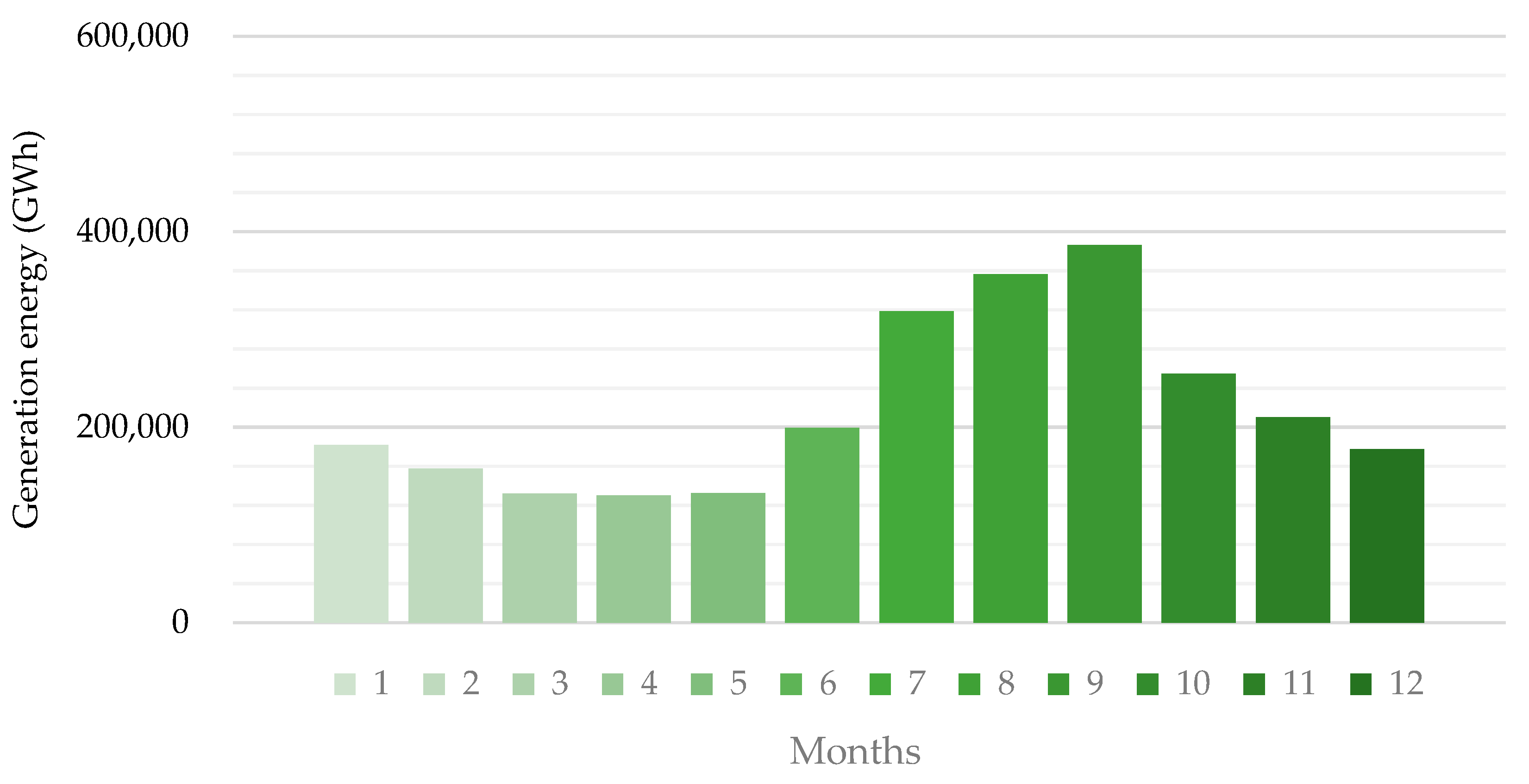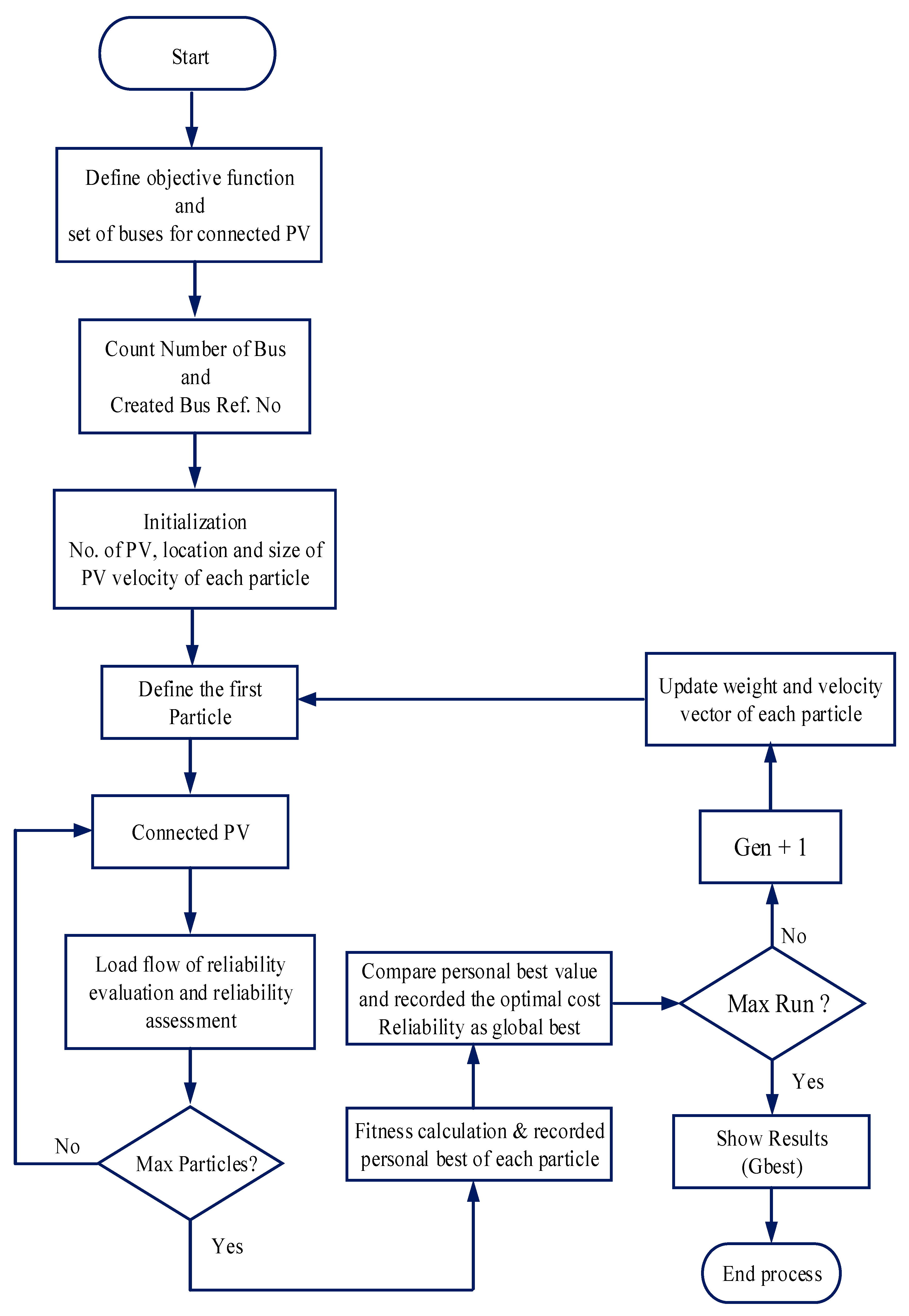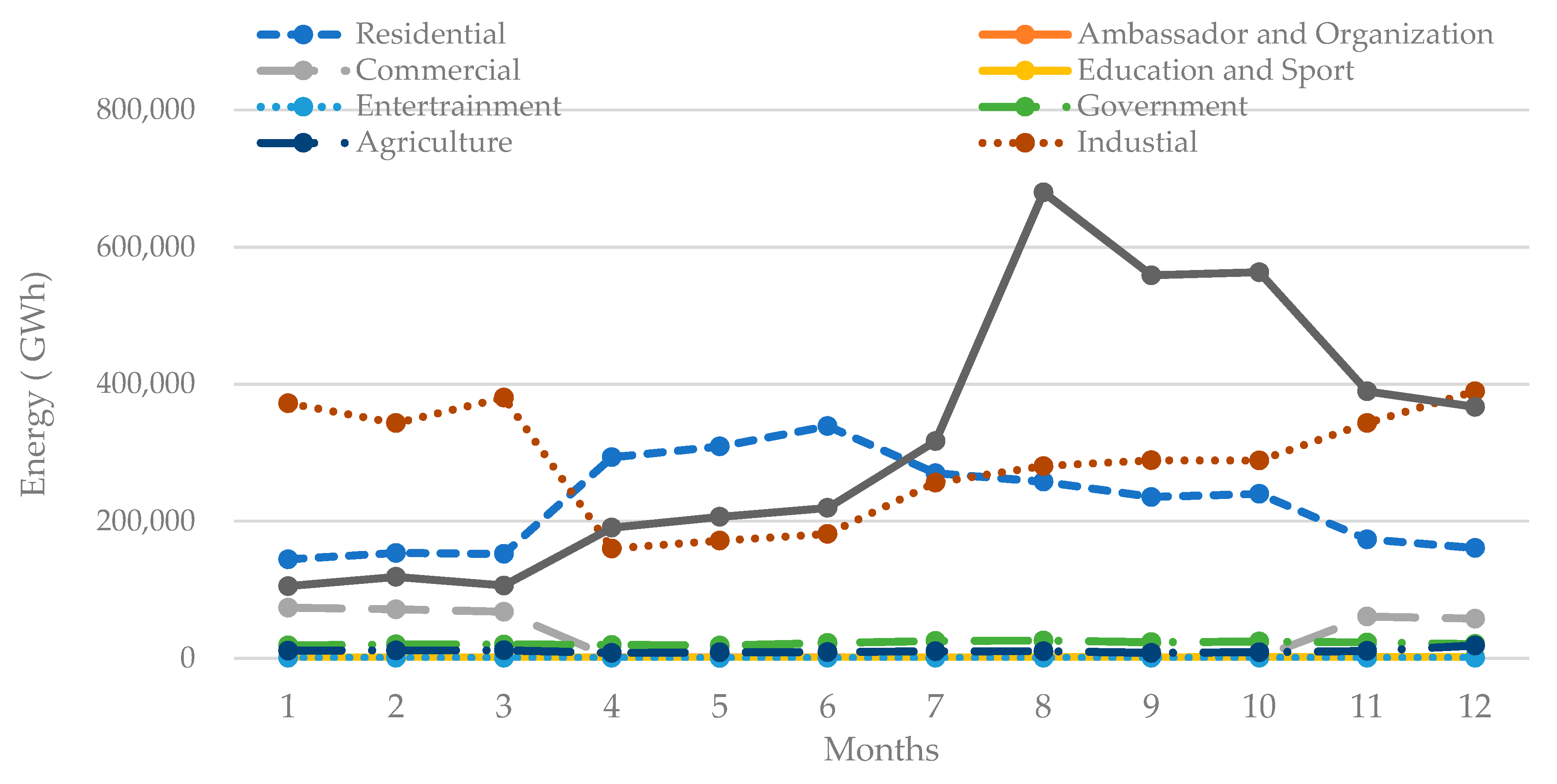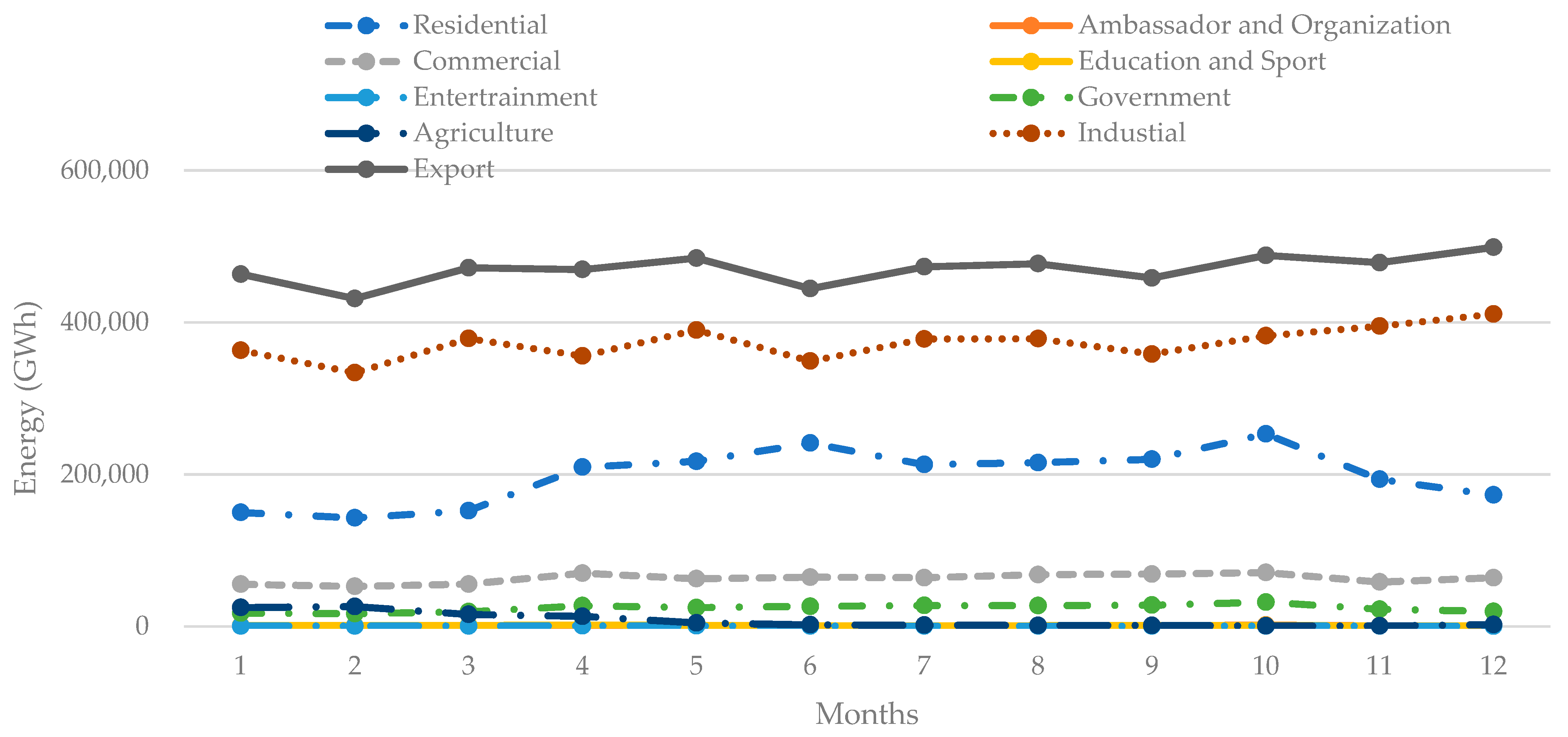Challenge of Supplying Power with Renewable Energy Due to the Impact of COVID-19 on Power Demands in the Lao PDR: Analysis Using Metaheuristic Optimization
Abstract
:1. Introduction
2. Effect of COVID-19 Pandemic on Power Supply System
3. Power Supply System Planning after COVID-19 Recovery
3.1. Power Generation
3.2. Modeling of Load and Demand
4. Power System Supply and Renewable Energy Challenge after COVID-19 Recovery
4.1. The Value of PV Connection
4.2. Power Loss in System
4.3. Value of Power Surplus with PV Connection
4.4. The Reliability Value
5. The Line Investment Cost (Cinvt)
Power Supply after COVID-19 Recovery
6. Engineering Economy
6.1. Investment Cost
6.2. Present Worth Calculations with Inflation
6.3. Net Present Value
7. National Network Data
8. Results and Discussion
9. Conclusions
Author Contributions
Funding
Institutional Review Board Statement
Informed Consent Statement
Data Availability Statement
Acknowledgments
Conflicts of Interest
References
- Ibn-Mohammed, T.; Mustapha, K.B.; Godsell, J.; Adamu, Z.; Babatunde, K.A.; Akintade, D.D.; Acquaye, A.; Fujii, H.; Ndiaye, M.M.; Yamoah, F.A.; et al. A critical analysis of the impacts of COVID-19 on the global economy and ecosystems and opportunities for circular economy strategies. Resour. Conserv. Recycl. 2020, 164, 105169. [Google Scholar] [CrossRef] [PubMed]
- Elavarasan, R.M.; Shafiullah, G.M.; Raju, K.; Mudgal, V.; Arif, M.T.; Jamal, T.; Subramanian, S.; Balaguru, V.S.; Reddy, K.S.; Subramaniam, U. COVID-19: Impact analysis and recommendations for power sector operation. Appl. Energy 2020, 279, 115739. [Google Scholar] [CrossRef] [PubMed]
- Gollakota, A.R.; Shu, C.M. COVID-19 and energy sector: Unique opportunity for switching to clean energy. In International Association for Gondwana Research; Elsevier B.V.: Amsterdam, The Netherlands, 2022; Volume 114, pp. 751–7311. [Google Scholar]
- Abulibdeh, A. Modeling electricity consumption patterns during the COVID-19 pandemic across six socioeconomic sectors in the State of Qatar. Energy Strategy Rev. 2021, 38, 100733. [Google Scholar] [CrossRef]
- United Nations Lao PDR. Toward a COVID-19 Recovery Plan; Final Report; Financing for Sustainable Development and Effective Development Cooperation (Macro-Fiscal Framework); Ministry of Finance and United Nations Lao PDR: Vientiane, Laos, 2020; pp. 3–15. [Google Scholar]
- Chanthaboury, K. Socio-Economic Impact Assessment of COVID-19 on Lao PDR; Final Report; Ministry of Finance and United Nations Lao PDR: Vientiane, Laos, 2020. [Google Scholar]
- Japan International Cooperation Agency (JICA). Ministry of Energy and Mines Power Network System Master Plan in Lao PDR, 2020; Final Report; Japan International Cooperation Agency (JICA): Tokyo, Japan, 2020. [Google Scholar]
- Hoang, A.T.; Nižetić, S.; Olcer, A.I.; Ong, H.C.; Chen, W.H.; Chong, C.T.; Thomas, S.; Bandh, S.A.; Nguyen, X.P. Impacts of COVID-19 pandemic on the global energy system and the shift progress to renewable energy: Opportunities, challenges, and policy implications. Energy Policy 2021, 154, 112322. [Google Scholar] [CrossRef]
- Pilloni, M.; Kádár, J.; Abu Hamed, T. The Impact of COVID-19 on Energy Start-Up Companies: The Use of Global Financial Crisis (GFC) as a Lesson for Future Recovery. Energies 2022, 15, 3530. [Google Scholar] [CrossRef]
- Çelїk, D.; Meral, M.E.; Waseem, M. The progress, impact analysis, challenges and new perceptions for electric power and energy sectors in the light of the COVID-19 pandemic. Sustain. Energy Grids Netw. 2022, 31, 100728. [Google Scholar] [CrossRef]
- Amir, M.; Khan, S.Z. Assessment of renewable energy: Status, challenges, COVID-19 impacts, opportunities, and sustainable energy solutions in Africa. Energy Built Environ. 2022, 3, 348–362. [Google Scholar] [CrossRef]
- Navon, A.; Machlev, R.; Carmon, D.; Onile, A.E.; Belikov, J.; Levron, Y. Effects of the COVID-19 pandemic on energy systems and electric power grids—A review of the challenges ahead. Energies 2021, 14, 1056. [Google Scholar] [CrossRef]
- Arora, K.; Kumar, A.; Kamboj, V.K.; Prashar, D.; Shrestha, B.; Joshi, G.P. Impact of renewable energy sources into multi area multi-source load frequency control of interrelated power system. Mathematic 2021, 9, 186. [Google Scholar] [CrossRef]
- Zhuo, Z.; Zhang, N.; Yang, J.; Kang, C.; Smith, C.; O’Malley, M.J.; Kroposki, B. Transmission expansion planning test system for AC/DC hybrid grid with high variable renewable energy penetration. IEEE Trans. Power Syst. 2019, 35, 2597–2608. [Google Scholar] [CrossRef]
- Collaborative project between Lao People’s Democratic Republic and Thailand. Assessment of Solar Energy Potentials for Lao People’s Democratic Republic; Final Report; Digital Research Information Center: Bangkok, Thailand, 2007. [Google Scholar]
- Bertram, C.; Luderer, G.; Creutzig, F.; Bauer, N.; Ueckerdt, F.; Malik, A.; Edenhofer, O. COVID-19-induced low power demand and market forces starkly reduce CO2 emissions. Nat. Clim. Chang. 2021, 11, 193–196. [Google Scholar] [CrossRef]
- Lazo, J.; Aguirre, G.; Watts, D. An impact study of COVID-19 on the electricity sector: A comprehensive literature review and Ibero-American survey. Renew. Sustain. Energy Rev. 2022, 158, 112135. [Google Scholar] [CrossRef] [PubMed]
- Bielecki, S.; Skoczkowski, T.; Sobczak, L.; Buchoski, J.; Maciąg, Ł.; Dukat, P. Impact of the lockdown during the COVID-19 pandemic on electricity use by residential users. Energies 2021, 14, 980. [Google Scholar] [CrossRef]
- Ansari, M.R.; Pirouzi, S.; Kazemi, M.; Naderipour, A.; Benbouzid, M. Renewable generation and transmission expansion planning coordination with energy storage system: A flexibility point of view. Appl. Sci. 2021, 11, 3303. [Google Scholar] [CrossRef]
- Dev, S.M.; Sengupta, R. Impact of COVID-19 on the Indian Economy: An Interim Assessment; Indira Gandhi Institute of Development Research: Mumbai, India, 2020. [Google Scholar]
- Zhong, H.; Tan, Z.; He, Y.; Xie, L.; Kang, C. Implications of COVID-19 for the electricity industry: A comprehensive review. CSEE J. Power Energy Syst. 2020, 6, 489–495. [Google Scholar]
- Nayak, J.; Mishra, M.; Naik, B.; Swapnarekha, H.; Cengiz, K.; Shanmuganathan, V. An impact study of COVID-19 on six different industries: Automobile, energy and power, agriculture, education, travel and tourism and consumer electronics. Expert Syst. 2020, 39, e12677. [Google Scholar] [CrossRef]
- Zhang, D.; Li, H.; Zhu, H.; Zhang, H.; Goh, H.H.; Wong, M.C.; Wu, T. Impact of COVID-19 on urban energy consumption of commercial tourism city. Sustain. Cities Soc. 2021, 73, 103133. [Google Scholar] [CrossRef]
- Cui, Z.; Wu, J.; Lian, W.; Wang, Y.G. A novel deep learning framework with a COVID-19 adjustment for electricity demand forecasting. Energy Rep. 2023, 9, 1889–1895. [Google Scholar] [CrossRef]
- Keokhoungning, T.; Premrudeepeechacharn, S.; Wongsinlatam, W.; Namvong, A.; Remsungnen, T.; Mueanrit, N.; Sorn-in, K.; Kravenkit, S.; Siritaratiwat, A.; Srichan, C.; et al. Transmission network expansion planning with high penetration solar energy using particle swarm optimization in Lao PDR toward 2030. Energies 2022, 15, 8359. [Google Scholar] [CrossRef]
- Wang, P.; Du, E.; Zhang, N.; Xu, X.; Gao, Y. Power system planning with high renewable energy penetration considering demand response. Glob. Energy Interconnect. 2021, 4, 69–80. [Google Scholar] [CrossRef]
- Stativă, A.; Gonzalez-Longatt, F. Peer to peer (P2P) MATLAB-POWER FACTORY communication: Optimal placement and setting of power system stabilizer. In Advanced Smart Grid Functionalities Based on PowerFactory; Springer: Berlin/Heidelberg, Germany, 2018; pp. 301–318. [Google Scholar]
- Morquechoa, E.G.; Torres, S.P.; Castro, C.A. An efficient hybrid metaheuristics optimization technique applied to the AC electric transmission network expansion planning. Swarm Evol. Comput. 2021, 61, 100830. [Google Scholar] [CrossRef]
- Wanga, F.; Zhanga, H.; Zhoub, A.A. Particle swarm optimization algorithm for mixed-variable optimization problems. Swarm Evol. Comput. 2021, 60, 100808. [Google Scholar] [CrossRef]
- Sameer, H.A.; Gharghan, S.K.; Mutlag, A.H. Hybridization of particle swarm optimization algorithm with neural network for COVID-19 using computerized tomography scan and clinical parameters. J. Eng. 2023, 2023, e12226. [Google Scholar] [CrossRef]
- Ahmadian, A.; Elkamel, A.; Mazouz, A. An improved hybrid particle swarm optimization and tabu search algorithm for expansion planning of large dimension electric distribution network. Energies 2020, 13, 5631. [Google Scholar] [CrossRef]
- Sedighizadeha, D.; Masehianb, E.; Sedighizadehc, M.; Akbaripourd, H. GEPSO: A new generalized particle swarm optimization algorithm. Math. Comput. Simul. 2020, 179, 194–212. [Google Scholar] [CrossRef]
- Shami, T.M.; El-Saleh, A.A.; Alsaitti, M.; Al-Tasem, Q.; Summakiek, M.A.; Mirjalili, S. Particle Swarm Optimization: A Comprehensive Survey. IEEE Access. 2022, 10, 10031–10061. [Google Scholar] [CrossRef]
- Blank, L.T.; Tarquin, A.J.; Iverson, S. Engineering Economy; Mc Graw–Hill: New York, NY, USA, 2005. [Google Scholar]
- Abbasi, S.; Aldi, H. Return on investment in transmission network expansion planning considering wind generation uncertainties applying non-dominated sorting genetic algorithm. J. Oper. Autom. Power Eng. 2018, 6, 89–100. [Google Scholar]
- Gomesa, P.V.; Saraivaa, J.T.; Carvalhob, L.; Diasc, B.; Oliveirac, L. Impact of decision-making models in Transmission Expansion Planning considering large shares of renewable energy sources. Electr. Power Syst. Res. 2019, 174, 105852. [Google Scholar] [CrossRef]








| Parameter | Value |
|---|---|
| Transmission lines | 874 lines with 149 buses |
| Generation | 1754 MW with an increase according to the National Power Development Plan (NPDP) |
| Demand | 1554 MW in 2020 and 1653 in 2021 |
| Transmission line cost | 430,000 USD/km/circuit (500 kV), 230,000 USD/km/circuit (230 kV), and 120,000 USD/km/circuit (115 kV) |
| PV power purchasing cost | 0.053 USD/kWh |
| PV power selling cost | 0.072 USD/kWh |
| Description | 2020 | 2021 |
|---|---|---|
| Added lines/ equipment | None | 115 kV single-circuit line from Thanaleng, Lao PCR, to Nong Khai, Thailand, with a length of approximately 11.5 km |
| No. of buses added | None | 21 buses |
| PV capacity (MW) | 175 MW | |
| Total active power generation (MW) | 1554 | 1753 |
| Total reactive power | 45.46 | 65.2 |
| Total load in the system (MW) | 1414.97 | 1642.70 |
| Total value from adding PV (USD 1 million) | None | 3.7 |
| Description | Economic Evaluation for 2021 | |
|---|---|---|
| Investment cost of line/ equipment | USD 2.17 million | 115 kV single-circuit Thanaleng-to-Nongkhai line with a length of approximately 11.5 km |
| Power purchasing and selling | USD 0.064/0.072 | Average |
| The average power flow in the new line | 36.5 MW | Including exports and imports |
| O&M per year | USD 0.217 million | Line and equipment lifecycle of 20 years |
| Value adding PV | USD 3.46 million | Total bus added PV is 21 buses/175 MW of PV’s Capacities |
| Power losses/reliablility comparision | With PV | Without PV |
| Power losses | 35.16 MW | 36.47 MW |
| Reliability | 94.72 T/year | 101.54 T/year |
| IRR | 30% | |
| NPV | USD 9.5 million | With a discount rate of 6% |
Disclaimer/Publisher’s Note: The statements, opinions and data contained in all publications are solely those of the individual author(s) and contributor(s) and not of MDPI and/or the editor(s). MDPI and/or the editor(s) disclaim responsibility for any injury to people or property resulting from any ideas, methods, instructions or products referred to in the content. |
© 2023 by the authors. Licensee MDPI, Basel, Switzerland. This article is an open access article distributed under the terms and conditions of the Creative Commons Attribution (CC BY) license (https://creativecommons.org/licenses/by/4.0/).
Share and Cite
Keokhoungning, T.; Wongsinlatam, W.; Remsungnen, T.; Namvong, A.; Khunkitti, S.; Inthakesone, B.; Siritaratiwat, A.; Premrudeepreechacharn, S.; Surawanitkun, C. Challenge of Supplying Power with Renewable Energy Due to the Impact of COVID-19 on Power Demands in the Lao PDR: Analysis Using Metaheuristic Optimization. Sustainability 2023, 15, 6814. https://doi.org/10.3390/su15086814
Keokhoungning T, Wongsinlatam W, Remsungnen T, Namvong A, Khunkitti S, Inthakesone B, Siritaratiwat A, Premrudeepreechacharn S, Surawanitkun C. Challenge of Supplying Power with Renewable Energy Due to the Impact of COVID-19 on Power Demands in the Lao PDR: Analysis Using Metaheuristic Optimization. Sustainability. 2023; 15(8):6814. https://doi.org/10.3390/su15086814
Chicago/Turabian StyleKeokhoungning, Thongsavanh, Wullapa Wongsinlatam, Tawun Remsungnen, Ariya Namvong, Sirote Khunkitti, Bounmy Inthakesone, Apirat Siritaratiwat, Suttichai Premrudeepreechacharn, and Chayada Surawanitkun. 2023. "Challenge of Supplying Power with Renewable Energy Due to the Impact of COVID-19 on Power Demands in the Lao PDR: Analysis Using Metaheuristic Optimization" Sustainability 15, no. 8: 6814. https://doi.org/10.3390/su15086814








